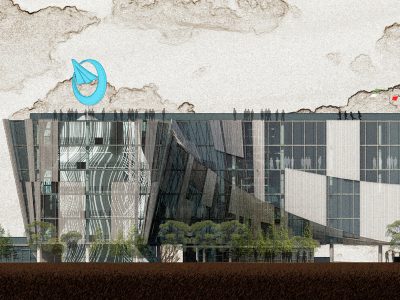Project description:
This is not just a business project to collect money, it’s an architectural project designed to encourage and improve the quality of the community that lives in this place outside the Shanghai city center. Giving birth to a shopping mall in front of a residential area was a big courageous choice that forced us to make drastic decisions regarding the distribution of space, the relocation of greenery, a common space for the community and an area commercial that was not too aggressive towards those who live a few meters from the building
The three sites (c9, g4, g5) are closely related to each other both from an aesthetic and functional point of view. The primary thing that was thought about, regarding these future buildings, was integration into the urban context. The future commercial building will have to be perfectly integrated in a fully expanding area, where there is already a 5-minute subway line by car, a bus line and the 2 highways connected directly to the Pudong airport and the city center of Shanghai.
This Shopping mall aims to be an urban example of all the other shopping malls connected with the housing units of the entire area.
Level 1
Building C9 will be connected with a bridge to facilitate the crossing of pedestrians and also to facilitate the elderly and disabled people who want to move from one area to another.
Access to the basement area is arranged on the east front for the entrance and west for the exit.
All services for baby care and other public services will be located on the first floor.
The G4 and G5 area has been automatically connected in one building and between the two areas the main entrance of the shopping mall has been inserted but also the entrance to the adjacent residential area in the north area
On the north front, behind the building, a small park and a green square have been created for the socialization of the community. In this area it will be possible to enter directly into the commercial area.
The accesses of block G4 and G5 for the machines in the basement have been inserted in the south front.
It was designed for the bus station shelter with an information service near the entrance. The canteen, kindergarten, baby care and service point and most of the restaurants will be located on the ground floor
All these services must be easy to access for the community and users.
Level 2
Refreshment and commercial area
Some green spaces have been created for bars and restaurants inside the shopping mall that could be comfortable for a young generation and beyond.
Level 3, Level 4, Level 5
Commercial area
Rooftop
Vegetable gardens for communities and restaurants
The revolution of this project was precisely to insert the vegetable gardens on the terrace.
We have an immense area available to guarantee residents and restaurants to grow their vegetables on the terrace with healthy and safe organic products.
Who will come to eat in this shopping mall, will eat organic and healthy with reduced costs since there is no external transport of vegetables. Or residents will be able to cook vegetables at home and grow them daily. Each resident will be able to rent their own vegetable garden and have their own vegetables.
This is intended to be an example of conscious green-business at kilometer 0 for the entire community of this area.
Materials
The preponderant materials have been chosen to be best placed within this urban context.
The building will have a mixed structure in reinforced concrete and metal
Part of the exposed facade will be used a ventilated perforated aluminum facade
Some parts of the facade and the emergency stairs will have a perforated steel facade to allow proper ventilation of the building.
Green Technology and energy saving
Green roof
Wind driven ventilation
Daylight strategies
Plant-e
Water Recycling
Solar Panel
Green technology can save us from 15% to 30% if applied correctly, and it is an investment and energy savings for the whole local Chinese community.
In all the facades of the building there will be plants and bamboo, in order to lower the temperature of the building, creating shade and refreshment in the hottest periods, filtering the air from smog and creating a biocompatible impact with citizens.
Green roof
The green roofs includes a waterproof membrane together with layers of additional components, as well as means of growth, drainage and root protection – allowing vegetation to spread over all or part of the roof surface. Green roofs have many applications, from industrial plants to residences and offices to other commercial properties.
Green roofs insulate buildings by preventing the transmission of heat through the roofs. The lower heat gain from the roof reduces the energy required for air conditioning. This effect can be maximized with low soil density and high moisture content. The benefits of this lower solar heat gain are more fully realized in warm climates such as Hong Kong, where energy costs for air conditioning are high. However, this advantage is less significant in multi-storey buildings, given the low ratio between the roof area and the total facade of the exposed building.
Low-e Glass technology and solar panels
Low-e glass stands for low emissivity glass. This type of glass has a special transparent metal coating, which is capable of reflecting most of the infrared rays while transmitting most of the visible sector of the solar spectrum. This low-e glass manages the sun’s heat by filtering the sun’s long wave radiation. This reduces the amount of solar heat gain in the building.
Wind driven ventilation
As the natural wind blows through a building, the air pressure on the windward wall increases. The wind moves around the building and decreases the air pressure on the leeward wall as it leaves, providing a suction effect. The fresh air rushes into the openings of the windward walls and exits from the leeward openings of the building, alleviating the pressure differences on the two walls. In wind ventilation, the shape of the building is a crucial factor. With proper design, it can create wind pressure that effectively guides the flow of air through the openings of a building.
Daylighting Strategies Daylight can be introduced into a building using a variety of design concepts and strategies. Daylight can be captured and directed into a building via windows, light shelves, light tubes and skylights. These openings capture the light directly or through channels to light up the relevant space. The location and design of windows influence the effectiveness of daylight utilization significantly. Building orientation, weather and potential obstructions also affect how much light is captured.
Daylight strategies
Daylight can be introduced into a building using a variety of design concepts and strategies. Daylight can be captured and directed into a building through windows, light shelves, light tubes and skylights. These openings capture light directly or through the channels to illuminate the relevant space. The position and design of the windows significantly influence the effectiveness of using daylight. The orientation of the building, weather conditions and potential obstacles also affect the amount of light captured.
Plant-e
Plant-e develops products in which electricity is generated with live plants. The products are based on a technology developed at the university of Wageningen. In 2007 the technology was patented and Plant-e was able to obtain patents from the university in 2009. The technology allows us to generate electricity with live plants in practically every place where plants can grow and water is abundantly available.
Water recycling
Possibility of recovery of rainwater, date of the average annual rainfall and the collection area available,
need for recovery, or the quantity you want to dispose of.
The Rainwater Gazebo Recovery system combines the storage of rainwater, by means of an accumulation tank with filtering systems, with the reuse by means of a pumping group with a self-priming multistage centrifugal pump or with submersible electric pump and related accessories for correct operation.
Solar Panel
With various government incentives it’s possible to take advantage of this technology now.
Using solar panels is a very practical way to produce electricity for many applications. The obvious would have to be off-grid living. Living off-grid means living in a location that is not serviced by the main electric utility grid. Remote homes and cabins benefit nicely from solar power systems. No longer is it necessary to pay huge fees for the installation of electric utility poles and cabling from the nearest main grid access point. A solar electric system is potentially less expensive and can provide power for upwards of three decades if properly maintained.



